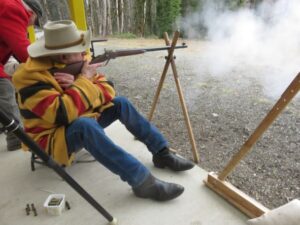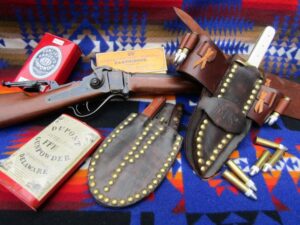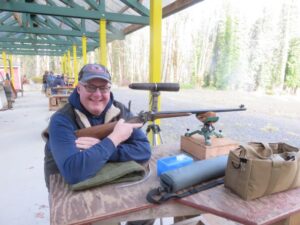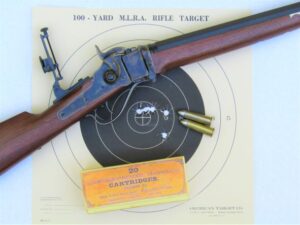
By Mike Nesbitt | Contributing Editor
Once again, the “boom” of the big .50s could be heard at the Capitol City Rifle & Pistol Club south of Olympia, Washington, along with the mixture of the sharper “crack” of the few smaller bores that participated in the Black River Buffalo Runners’ annual .50/70 match.
This black powder cartridge match does not exclude other calibers from joining in the fun but the .50/70 rifles do take priority and those other black powder cartridge calibers are scored separately. Shooting these old buffalo guns, or the modern made versions, is a real “blast” and they are more than capable of producing some very good scores.
The old .50/70 was our first center fire cartridge, developed at Springfield arsenal in 1866 and it was a popular standard chambering in the Sharps rifles of 1869 and 1874 Models as well as in the Remington rolling blocks plus the Springfield rifles until it was replaced by the .45/70 in the Model 1873. Several of the old buffalo hunters used the .50/70 such as Buffalo Bill Cody and also “Wild Bill” Hickok. It was said on the buffalo ranges that “nothing kills like a .50” and while the smaller calibers were more accurate, especially at the longer ranges, the .50/70 continued to be heard on the plains.
The .50/70 cartridge, for those who might not know, generally shoots a 450-grain lead bullet powered by 70 grains of black powder. That was the standard military loading. In the old days, sporting loads used paper patched bullets weighing 425 grains over the same powder charge. Other bullet weights available for sporting loads included 457 grains, 473 grain paper patched, and some 500-grain paper patched loads. Compared to several other cartridges, the .50/70 looks somewhat short and stubby with a case length of only 1 ¾ inches.

The real “Big .50” is the .50/90 Sharps which has the 2 ½ -inch long case but in the writings from the 1870s there was usually no distinction between the two .50s. The two calibers were both called the “Big .50.” Our .50/70 match is somewhat in honor of those old times but it’s really a great chance for us to have some fun doing good shooting with this old cartridge. Let me tell you about some of the shooters and the rifles they have.
First, I must mention Allen Cunniff. He took 1st place in this match with very good scores, shooting his Model 1874 Sharps, by C. Sharps Arms, using paper patched bullets. Allen is no stranger to shooting paper patched bullets in his loads and he got a nice deer a couple of seasons ago with that same rifle. We might say that Allen sets the pace for a lot of us and trying to keep up with him is sometimes hard to do. Allen shot the high scoring targets at both 100, an 89, and 200 yards, and 88-X. He uses heavy bullets in his .50/70, 555 grain slugs.

In second place you find me and this year I was using the rifle I call “Moonbeam,” a .50/70 by C. Sharps Arms with a number 1 ¾ Heavy barrel, sighted with a Deluxe Vernier tang sight and a spirit level front sight. The bullets I was using were cast from a mold made by Accurate Molds, #52-460N, which is a bullet of my design, trying to get close to the old 457 grain sporting load. We do our shooting from the sitting position while using cross-sticks, much like the old buffalo hunters did, and I got a score of 82 on both of my 100- and 200-yard targets for a match score of 164-X out of 200.
My load used the bullets from the Accurate mold over 63 grains of Swiss 1 1/2Fg black powder. That’s not quite a full load but the paper targets we shoot at certainly can’t tell the difference. For the last couple of years, I used 65 grains of powder under the bullets but recently dropped the load to 63 grains which seems to group a tiny bit better.

Just behind me in Third place was Tom Witt shooting his brand-new rifle from C. Sharps Arms in a match for the first time. I know that Tom sighted his new rifle in just the day before the match but he did that from a benchrest. Shooting over the crossed-sticks is just a little different than shooting from the bench so Tom’s sight settings needed to be “tweaked” just a little but he did get some good targets. While I got 82 on both of my targets, Tom followed closely and got 79 on both of his targets, that’s unusual.
My old shooting partner Bob DeLisle shot his way into Fourth place and Bob also uses paper patched bullets. Bob’s rifle is another Sharps by C. Sharps Arms but his is the Hunter’s Rifle/Carbine with a 26-inch barrel. And Bob uses a rear sight that is a copy of the old Sharps sporting tang sight which doesn’t have a turn-screw adjustment. He does some very good shooting with that rifle, one of the lighter-weight Sharps on our firing line.
In Fifth place was “Loco” Jeff Ritter shooting a re-built rolling block Remington in .50/70 caliber. Jeff’s rifle is stocked like a Hawken so it can be called a Gemmer/Remington. (J.P. Gemmer bought the Hawken Shop from Sam Hawken and was known to restock some of the early cartridge rifles to look like Hawkens, such as the Spencers.)
Phil Wiebe used his Shiloh Sharps ‘Business Rifle’ in .50/70 to take 6th place and I’d comment on Phil’s loads but I’m not completely sure of what he was using. He got off to a slow start at 100 yards but came back strong at 200 yards, getting the second-highest score at that longer distance for this match, an 84-2X.
Jerry Mayo used his nicely re-built (by C. Sharps Arms) Remington rolling block to take 7th place. That’s downhill from a couple of years ago when Jerry borrowed my .50/70 rolling block and used it to win the match. I used the same rifle that year and placed third. Jerry’s rifle is a real eyeful and he’s used to getting higher scores.
Next in line was Ed Lagergren and he was shooting his very special heavy .50/70 Sharps in a match for the first time. He might tell you that no matter how well prepared you are, there is nothing that will get you completely ready for “the first time” in a match. Ed is the owner of the Oak Meadows Buffalo Range near Porter, Washington and while he didn’t actually get his rifle for buffalo hunting, he certainly did want a rifle to represent the guns of the old buffalo hunters. Ed’s heavy rifle is really worth a second look.

In addition to those eight shooters, we also had shooters who didn’t have .50/70 rifles to compete with. Those shooters are not turned away, they’re more than welcome, but the 50/70 rifles do prevail in the scoring and for the awards.
First among these ‘other’ shooters was Ken Kurfurst shooting a recently acquired Remington Hepburn in .40/82 caliber. That’s, basically, a .45/90 necked down to .40 caliber. Ken used it to shoot the highest and most enviable scores for the day, getting a 94-4X at 100 yards and a 92-2X at 200 yards for a total of 186-6X. That’s hard to beat shooting black powder rifles with cast bullets and iron sights. He outshot all of the .50/70 shooters.
Next among these ‘others’ was Curt Lokovsek with another Remington Hepburn (from 1879) but in .45/90 caliber. Curt shot well and would have placed 4th for the day if we weren’t giving the main attention to the .50/70 rifles.
Following Curt were Will Ulry and Mark Davis, both shooting Shiloh Sharps rifles in .45/70 caliber. The .45/70s plus the .45/90 and especially the .40/82 were the guns that gave the sharper “crack” in their reports which simply emphasize how the .50/70s have a sound that is all their own.
Our shooting wasn’t done at the conclusion of the .50/70 match, we had an “after-match” for our “camp guns.” For this we used .44/40s, one .38/40, and one .32/20 all with black powder loads for a shoot-off at 100 and then at 50 yards. At 100 yards we shot from the sitting position at a reduced-size buffalo gong. Bob DeLisle and I took the lead in the after-match with four out of five hits each. Then we shot at a “bucket” gong placed at 50 yards, shooting offhand. Again, Bob DeLisle and I tied with five hits each, giving us both a total of nine hits. To break the tie, we shot offhand at the 100-yard buffalo again. Using my Model 1873 in .44/40 with the 30-inch barrel, I was lucky enough to hit it. Bob, with his old Model 1892 Short Rifle in .32/20, shot just a bit low, giving me the win.
That’s the rundown on our .50/70 match. We’ll do this again next February and the only difference we expect is that we’ll have more shooters. There is something truly addicting about the ‘boom’ of the big .50s.



